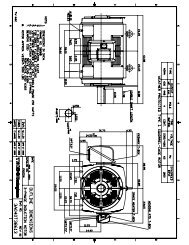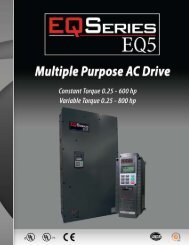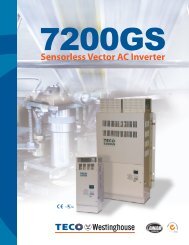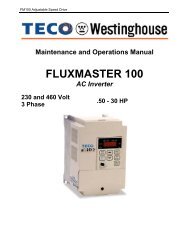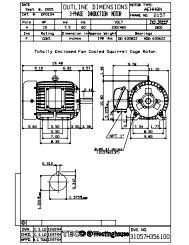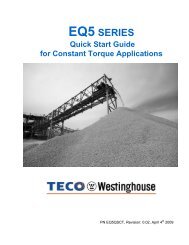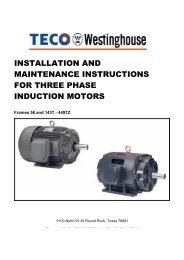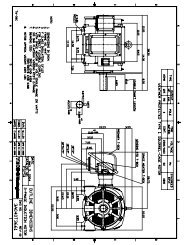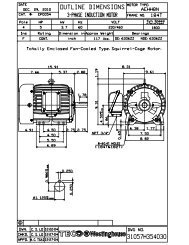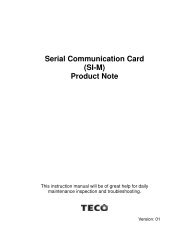EQ7 Series Instruction Manual - TECO-Westinghouse Motor Company
EQ7 Series Instruction Manual - TECO-Westinghouse Motor Company
EQ7 Series Instruction Manual - TECO-Westinghouse Motor Company
You also want an ePaper? Increase the reach of your titles
YUMPU automatically turns print PDFs into web optimized ePapers that Google loves.
Table 2.7 Symbols, Names and Functions of the Control Circuit Terminals (Continued)<br />
Classification<br />
Symbol Name Functions<br />
Programmable<br />
logic controller<br />
<br />
Programmable<br />
logic controller<br />
<br />
[PLC]<br />
SINK<br />
[PLC]<br />
SINK<br />
SOURCE<br />
[X1] t o [ X7],<br />
[FWD], [REV]<br />
Photocoupler<br />
+24 VDC<br />
SOURCE<br />
[X1] to [X7],<br />
[FWD], [REV]<br />
Photocoupler<br />
+24 VDC<br />
Digital input<br />
Analog output<br />
<br />
[FM1]<br />
[FM2]<br />
[CM]<br />
(a) With the switch turned to SINK<br />
[CM]<br />
Figure 2.15 Circuit Configuration Using a PLC<br />
(b) With the switch turned to SOURCE<br />
For details about the slide switch setting, refer to <strong>Instruction</strong> manual for section 2.3.6 "Setting up the slide switches."<br />
• For inputting a pulse train through the digital input terminal [X7]<br />
• Inputting from a pulse generator with an open collector transistor output<br />
Stray capacity on the wiring between the pulse generator and the inverter may disable transmission of the pulse<br />
train. As a countermeasure against this problem, insert a pull-up resistor between the open collector output<br />
signal (terminal [X7]) and the power source terminal (terminal [PLC]) if the switch selects the SINK mode input;<br />
insert a pull-down resistor between the output signal and the digital common terminal (terminal [CM]) if the switch<br />
selects the SOURCE mode input.<br />
A recommended pull-up/down resistor is 1k 2 W. Check if the pulse train is correctly transmitted because stray<br />
capacity is significantly affected by the wire types and wiring conditions.<br />
Analog<br />
monitor<br />
[11] Analog<br />
common<br />
Both terminals output monitor signals for analog DC voltage (0 to +10 V) or analog DC current<br />
(+4 to +20 mA). The output form (VO/IO) for each of [FM1] and [FM2] can be switched with the<br />
slide switches on the control PCB and the function codes, as listed below.<br />
Terminal<br />
[FM1]<br />
[FM2]<br />
Terminal function is<br />
specified by:<br />
Output form<br />
Analog DC voltage Analog DC current<br />
Content is<br />
specified by:<br />
Slide switch SW4 VO1 IO1 Function code<br />
Function code F29 0 1<br />
F31<br />
Slide switch SW6 VO2 IO2 Function code<br />
Function code F32 0 1<br />
F35<br />
The signal content can be selected from the following with function codes F31 and F35.<br />
• Output frequency • Output current • Output voltage<br />
• Output torque • Load factor • Input power<br />
• PID feedback amount • Speed (PG feedback value) • DC link bus voltage<br />
• Universal AO • <strong>Motor</strong> output • Calibration<br />
• PID command<br />
• PID output<br />
* Input impedance of the external device: Min. 5k (at 0 to 10 VDC output)<br />
(While the terminal is outputting 0 to 10 VDC, it is capable of driving up to two analog<br />
voltmeters with 10 k impedance.)<br />
* Input impedance of the external device: Max. 500 (at 4 to 20 mA DC output)<br />
* Adjustable range of the gain: 0 to 300%<br />
Two common terminals for analog input and output signals.<br />
These terminals are electrically isolated from terminals [CM] and [CMY].<br />
2-22




